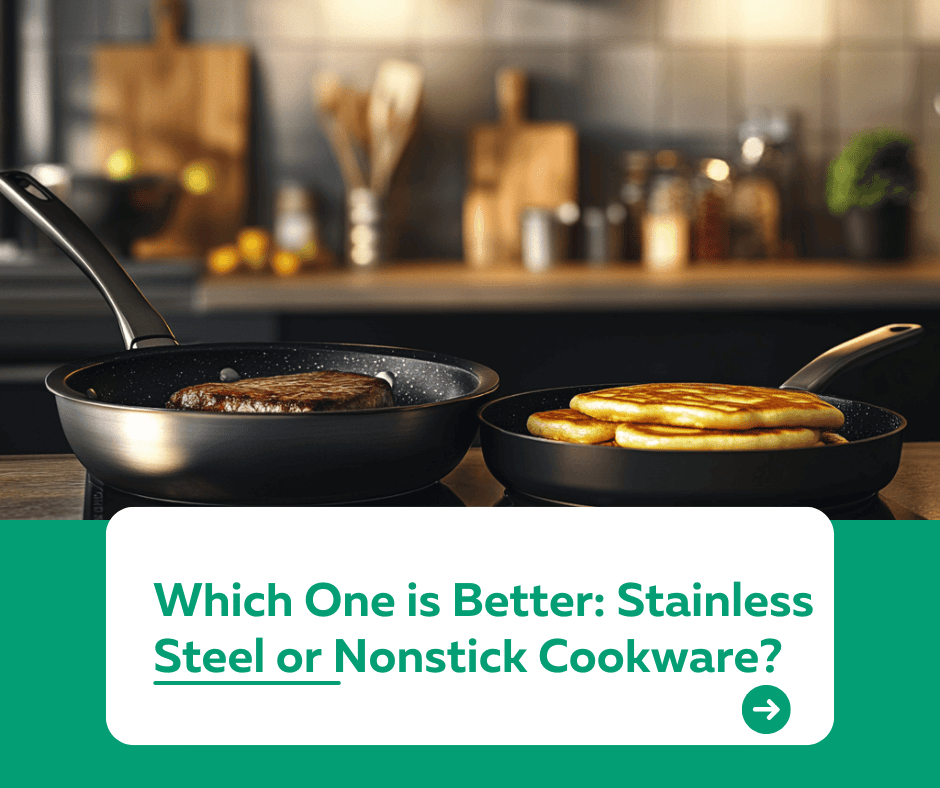
Introduction
Cookware is a cornerstone of any kitchen, but choosing between stainless steel and nonstick pots and pans can be challenging. Which one is better for your cooking needs? Let’s compare these two popular options to help you decide.
1. Stainless Steel Cookware
Advantages
✅ Durability: Stainless steel is incredibly durable and resistant to scratches and dents.
✅ High Heat Tolerance: Ideal for searing, browning, and deglazing.
✅ Non-Reactive: Does not react with acidic foods, preserving flavors.
✅ Versatility: Suitable for stovetops, ovens, and broilers.
Disadvantages
- Sticking Issues: Food can stick without proper oiling or seasoning.
- Maintenance: Requires polishing to maintain its shine.
- Heat Conductivity: Often needs a multi-ply base for even heat distribution.
Best For
- Searing meat, sautéing vegetables, and cooking sauces.
2. Nonstick Cookware
Advantages
✅ Ease of Use: The nonstick coating makes cooking and cleaning effortless.
✅ Lightweight: Easier to handle and maneuver.
✅ Healthier Cooking: Requires less oil for cooking.
✅ Perfect for Delicate Foods: Great for eggs, pancakes, and fish.
Disadvantages
- Durability: Coating can wear off over time and is prone to scratches.
- Heat Limitations: Not suitable for high-heat cooking.
- Chemical Concerns: Overheating can release harmful chemicals from some coatings.
Best For
- Low to medium heat cooking, including eggs, pancakes, and light sautéing.
3. Key Comparisons
| Feature | Stainless Steel | Nonstick |
|---|---|---|
| Durability | Long-lasting and scratch-resistant | Coating wears off over time |
| Heat Tolerance | High, ideal for searing and browning | Limited, not ideal for high heat |
| Ease of Cleaning | Requires effort, especially for stuck food | Easy to clean |
| Cooking Style | Best for high-heat, versatile cooking | Ideal for delicate, low-fat dishes |
4. Which One Should You Choose?
Choose Stainless Steel If:
- You cook with high heat and enjoy techniques like searing and browning.
- Durability and long-term investment are important to you.
- You don’t mind the extra effort to clean and maintain it.
Choose Nonstick If:
- You prioritize convenience and easy cleaning.
- You often cook delicate foods like eggs or fish.
- You want a lightweight option for everyday use.
5. Caring for Your Cookware
Stainless Steel
- Use oil to prevent sticking and preheat before adding food.
- Clean with a gentle scrubber and avoid abrasive materials.
- Polish occasionally to maintain its shine.
Nonstick
- Avoid using metal utensils to protect the coating.
- Wash by hand with mild soap; avoid dishwashers.
- Replace when the coating starts to peel or wear off.
Conclusion
Both stainless steel and nonstick cookware have their strengths and weaknesses, making them valuable for different types of cooking. Stainless steel is ideal for high-heat cooking and long-term durability, while nonstick is perfect for quick, low-heat meals with minimal cleanup. For the best of both worlds, consider keeping both in your kitchen.
For more kitchen insights, visit our Kuestion.com.